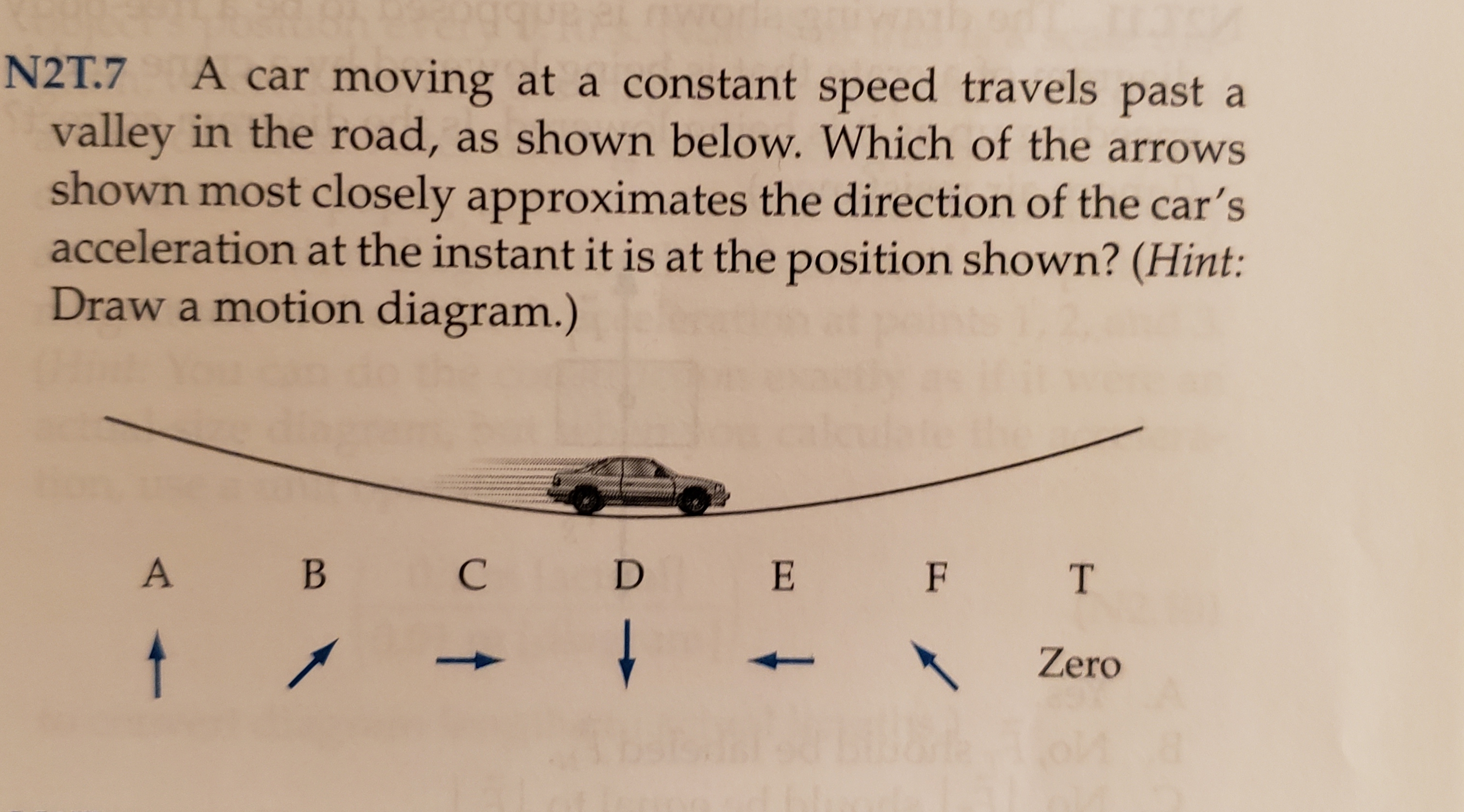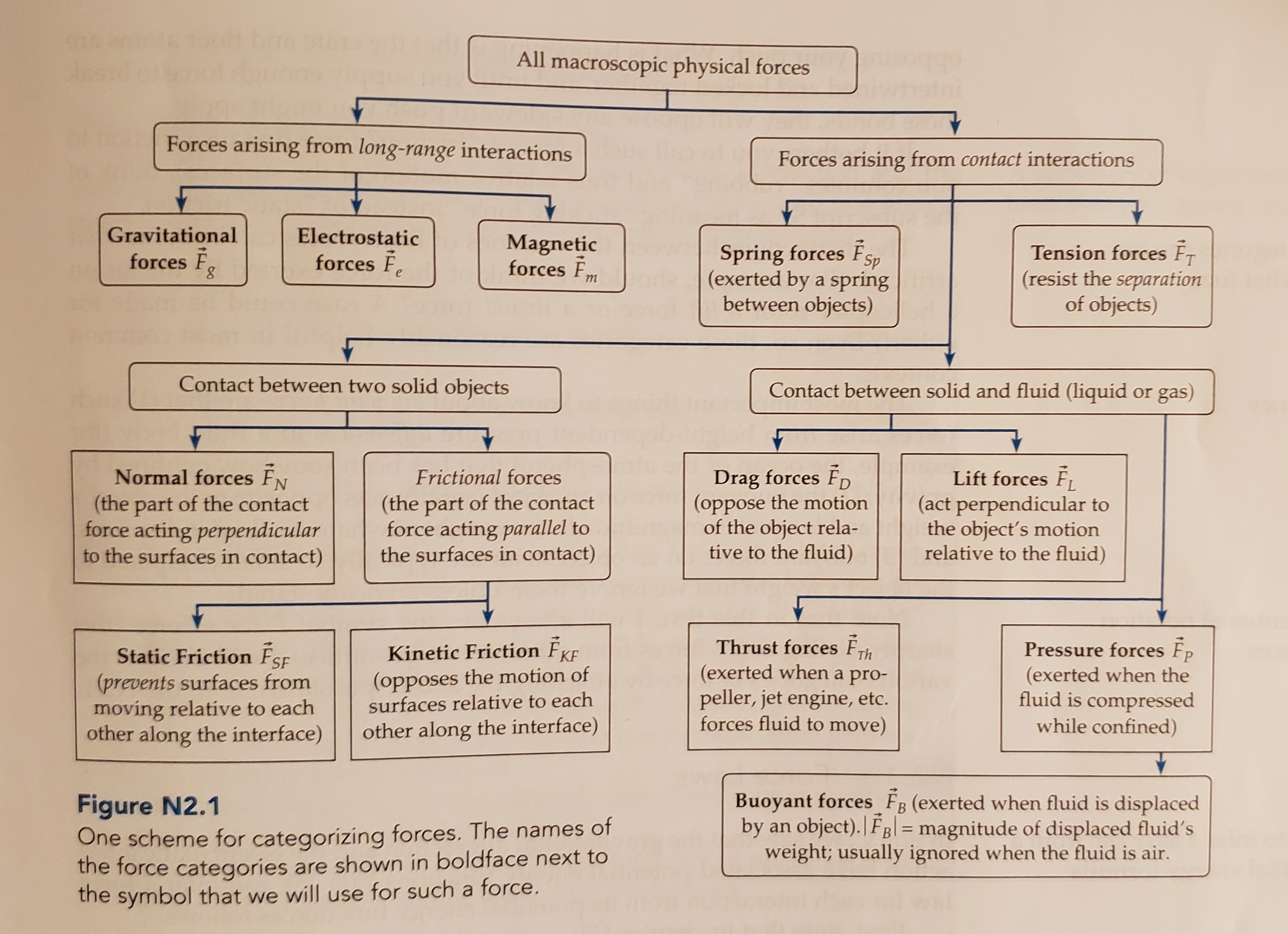N2T.7 A car moving at a constant speed travels past a valley in the road, as shown below. Which of the arrows shown most closely approximates the direction of the car's acceleration at the instant it is at the position shown? (Hint: Draw a motion diagram.) С В E F T Zero All macroscopic physical forces Forces arising from long-range interactions Forces arising from contact interactions Gravitational forces F Electrostatic Magnetic forces F, Tension forces FT (resist the separation of objects) Spring forces F forces F Sp (exerted by a spring between objects) m Contact between two solid objects Contact between solid and fluid (liquid or gas) Drag forces FD (oppose the motion of the object rela- tive to the fluid) Normal forces FN Lift forces F (act perpendicular to the object's motion relative to the fluid) Frictional forces (the part of the contact force acting perpendicular to the surfaces in contact) of the contact (the part force acting parallel to the surfaces in contact) Thrust forces Frh (exerted whena pro- peller, jet engine, etc. forces fluid to move) Kinetic Friction FKF (opposes surfaces relative to each Pressure forces Fp (exerted when the fluid is compressed while confined) Static Friction FsF (prevents surfaces from moving relative to each other along the interface) the motion of other along the interface) Buoyant forces F (exerted when fluid is displaced by an object). FB magnitude of displaced fluid's weight; usually ignored when the fluid is air. Figure N2.1 One scheme for categorizing forces. The names of the force categories are shown in boldfa ce next to the symbol th at we will use for such a force. 1
N2T.7 A car moving at a constant speed travels past a valley in the road, as shown below. Which of the arrows shown most closely approximates the direction of the car's acceleration at the instant it is at the position shown? (Hint: Draw a motion diagram.) С В E F T Zero All macroscopic physical forces Forces arising from long-range interactions Forces arising from contact interactions Gravitational forces F Electrostatic Magnetic forces F, Tension forces FT (resist the separation of objects) Spring forces F forces F Sp (exerted by a spring between objects) m Contact between two solid objects Contact between solid and fluid (liquid or gas) Drag forces FD (oppose the motion of the object rela- tive to the fluid) Normal forces FN Lift forces F (act perpendicular to the object's motion relative to the fluid) Frictional forces (the part of the contact force acting perpendicular to the surfaces in contact) of the contact (the part force acting parallel to the surfaces in contact) Thrust forces Frh (exerted whena pro- peller, jet engine, etc. forces fluid to move) Kinetic Friction FKF (opposes surfaces relative to each Pressure forces Fp (exerted when the fluid is compressed while confined) Static Friction FsF (prevents surfaces from moving relative to each other along the interface) the motion of other along the interface) Buoyant forces F (exerted when fluid is displaced by an object). FB magnitude of displaced fluid's weight; usually ignored when the fluid is air. Figure N2.1 One scheme for categorizing forces. The names of the force categories are shown in boldfa ce next to the symbol th at we will use for such a force. 1
Physics for Scientists and Engineers: Foundations and Connections
1st Edition
ISBN:9781133939146
Author:Katz, Debora M.
Publisher:Katz, Debora M.
Chapter4: Two-and-three Dimensional Motion
Section: Chapter Questions
Problem 57PQ
Related questions
Question
Please help answer the question and draw the associated free body diagram using the forces and notation given in the picture.

Transcribed Image Text:N2T.7 A car moving at a constant speed travels past a
valley in the road, as shown below. Which of the arrows
shown most closely approximates the direction of the car's
acceleration at the instant it is at the position shown? (Hint:
Draw a motion diagram.)
С
В
E
F
T
Zero

Transcribed Image Text:All macroscopic physical forces
Forces arising from long-range interactions
Forces arising from contact interactions
Gravitational
forces F
Electrostatic
Magnetic
forces F,
Tension forces FT
(resist the separation
of objects)
Spring forces F
forces F
Sp
(exerted by a spring
between objects)
m
Contact between two solid objects
Contact between solid and fluid (liquid or gas)
Drag forces FD
(oppose the motion
of the object rela-
tive to the fluid)
Normal forces FN
Lift forces F
(act perpendicular to
the object's motion
relative to the fluid)
Frictional forces
(the part of the contact
force acting perpendicular
to the surfaces in contact)
of the contact
(the
part
force acting parallel to
the surfaces in contact)
Thrust forces Frh
(exerted whena pro-
peller, jet engine, etc.
forces fluid to move)
Kinetic Friction FKF
(opposes
surfaces relative to each
Pressure forces Fp
(exerted when the
fluid is compressed
while confined)
Static Friction FsF
(prevents surfaces from
moving relative to each
other along the interface)
the motion of
other along the interface)
Buoyant forces F (exerted when fluid is displaced
by an object). FB magnitude of displaced fluid's
weight; usually ignored when the fluid is air.
Figure N2.1
One scheme for categorizing forces. The names of
the force categories are shown in boldfa ce next to
the symbol th at we will use for such a force.
1
Expert Solution
This question has been solved!
Explore an expertly crafted, step-by-step solution for a thorough understanding of key concepts.
This is a popular solution!
Trending now
This is a popular solution!
Step by step
Solved in 3 steps with 1 images

Knowledge Booster
Learn more about
Need a deep-dive on the concept behind this application? Look no further. Learn more about this topic, physics and related others by exploring similar questions and additional content below.Recommended textbooks for you

Physics for Scientists and Engineers: Foundations…
Physics
ISBN:
9781133939146
Author:
Katz, Debora M.
Publisher:
Cengage Learning

University Physics Volume 1
Physics
ISBN:
9781938168277
Author:
William Moebs, Samuel J. Ling, Jeff Sanny
Publisher:
OpenStax - Rice University

Principles of Physics: A Calculus-Based Text
Physics
ISBN:
9781133104261
Author:
Raymond A. Serway, John W. Jewett
Publisher:
Cengage Learning

Physics for Scientists and Engineers: Foundations…
Physics
ISBN:
9781133939146
Author:
Katz, Debora M.
Publisher:
Cengage Learning

University Physics Volume 1
Physics
ISBN:
9781938168277
Author:
William Moebs, Samuel J. Ling, Jeff Sanny
Publisher:
OpenStax - Rice University

Principles of Physics: A Calculus-Based Text
Physics
ISBN:
9781133104261
Author:
Raymond A. Serway, John W. Jewett
Publisher:
Cengage Learning

College Physics
Physics
ISBN:
9781938168000
Author:
Paul Peter Urone, Roger Hinrichs
Publisher:
OpenStax College

Physics for Scientists and Engineers, Technology …
Physics
ISBN:
9781305116399
Author:
Raymond A. Serway, John W. Jewett
Publisher:
Cengage Learning

Physics for Scientists and Engineers
Physics
ISBN:
9781337553278
Author:
Raymond A. Serway, John W. Jewett
Publisher:
Cengage Learning